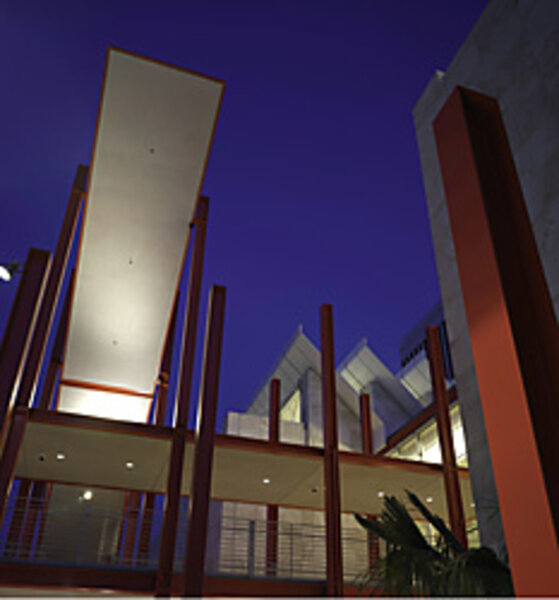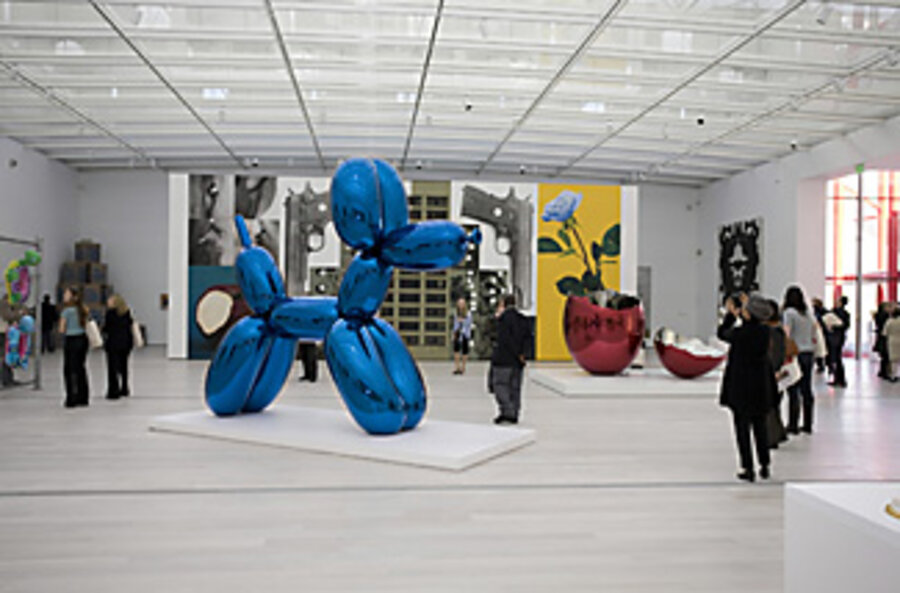In Los Angeles, an architectural marvel is the new town square
| Los Angeles
The quintessential image of Los Angeles is sprawl: endless freeways and far-flung neighborhoods without a center. No surprise the city's major museum, the Los Angeles County Museum of Art (LACMA), suffers the same malady. The 20-acre campus contains a hodgepodge of seven buildings stretching a third of a mile along Wilshire Boulevard. Until its recent, highly touted "transformation," the entrance was almost invisible.
"We had an architectural mess on our hands, and something had to be done," billionaire businessman and LACMA trustee Eli Broad admits in an interview published in a catalog heralding the debut of the new Broad Contemporary Art Museum (BCAM), which opened Feb. 16.
Philanthropist and civic leader Broad (pronounced Brode) who, with his wife, Edythe, has amassed an impressive collection of contemporary art, sought out veteran Italian architect Renzo Piano for a solution. The aim was not only to unify LACMA's campus and provide a showcase for contemporary art, but to give the entire city a focal point, the town square it so sorely lacks.
Piano designed a building to house rotating exhibitions of works from the Broads' collection, augmented by LACMA's holdings. He also devised a master plan to integrate the campus. On Wilshire, an installation by Chris Burden called "Urban Light" (202 vintage street lamps) marks the new entrance as triumphantly as klieg lights at a Hollywood première.
Visitors approach BCAM, Piano's elegant travertine-clad building, through a new Grand Entrance, an open-air, canopied space displaying large sculptures. Public plazas on both sides offer stunning vistas all the way to the Hollywood Hills. A covered walkway, accented with red steel I-beams, links the campus. Twenty species of palm trees (a botanical sculpture by artist Robert Irwin) flank this concourse.
Piano (esteemed architect of the additions to Atlanta's High Museum) entered what he calls a "ping-pong" relationship with Broad, batting ideas back and forth. Broad insisted that 80 percent of the new space be devoted to art – no gift shop, no restaurant. Broad could call the shots because he contributed $60 million to the project. All but 30 of the 178 works on view belong to the Broads and their art foundation, a sort of lending library that loans works to galleries across the US.
The inaugural exhibition at BCAM is housed in 60,000 square feet of column-free, loftlike gallery space, divided into two symmetrical wings united by a core of glass housing a giant elevator. An open-air, "Renzo red" escalator (dubbed "the spider") whisks museumgoers to the third floor to begin their visit. In luminous galleries lit by louvered skylights, natural light makes color virtually pop off canvases by Jasper Johns, Robert Rauschenberg, and Ellsworth Kelly. Each major figure from 1945 onward (including Lichtenstein, Warhol, and Jeff Koons) has a gallery to himself.
The only problem is that descending to the second floor seems like a comedown. Those galleries, showing works by more contemporary figures such as Damien Hirst and Cindy Sherman, are lit by artificial light and seem dim in comparison. The first floor, occupied by Richard Serra's two massive sculptures, one of which ("Band") consists of 200 tons of rusted loops of steel, is brightened by large sheets of glass.
Michael Govan, who joined the museum as director less than two years ago after construction had begun, contributed the idea of animating the Wilshire Boulevard facade with commissioned artworks. Two 52-foot banners by California conceptual artist John Baldessari "become part of the energy of the building," according to Mr. Govan.
In an "Architect's Statement," Piano seeks to blend what he calls "the spiritual and emotional uplift of art" into the round of everyday life. Unlike famous architects such as Frank Gehry or Daniel Libeskind, Piano has no signature, sculptural style, other than his insistence on a communal piazza and idiosyncratic rooflines (here presented as a sharp, shark-fin profile).
Like the southern California school of "light and space" artists such as Irwin and James Turrell, who dissolve their artworks into dazzling light to elevate the viewer's perception, BCAM appears like a mirage of simple form punctuated by vivid color. The new additions fulfill Irwin's mandate for a work of art: "to make you a little more aware than you were the day before of how beautiful the world is."






